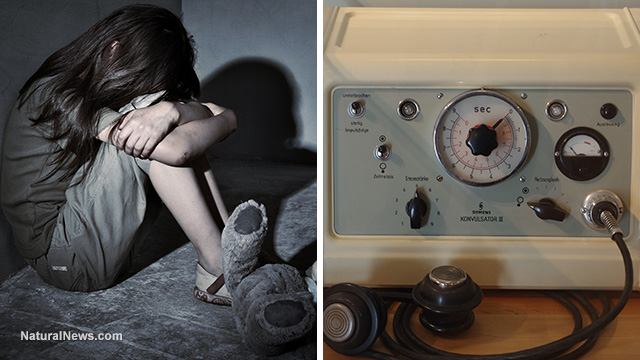American Psychiatric Association pushes for electroshock therapy for children and teens
Thursday, May 12, 2016 by: Julie Wilson staff writer
Tags: electroshock therapy, children, American Psychiatric Association

(NaturalNews) The American Psychiatric Association is pressuring the U.S. Food and Drug Administration to permit the use of electroshock therapy (ECT) on children and adolescents resistant to current therapies and drugs. The treatment, an archaic technique invented in the 1930s, sends jolts of electricity into the brain, inducing a seizure. It's associated with numerous side-effects, including short and long-term memory loss, cognitive problems, unwanted personality changes, manic symptoms, prolonged seizures, heart problems and death.
As recently reported, the FDA is considering a draft rule to declassify the risk of electroshock therapy or electroconvulsive therapy, from a Class III device, the highest risk category, to a Class II, defined as moderately risky. ECT has remained a Class III device since 1979, and is therefore subject to the highest level of regulatory control.
However, if ECT devices are recategorized to a Class II, opponents fear that the treatment could be used on a much larger population, which now may include children, because the devices would be eligible for "off-label" use.
'ECT is a degrading, damaging, memory robbing procedure'
If the FDA grants the APA's request, children unresponsive to psychiatric drugs will be subjected to the harsh and arguably inhumane treatment."ECT is a degrading, damaging, memory robbing procedure that should have been outlawed years ago," said Lee Spiller, Executive Director of Citizens Commission on Human Rights. "Shock machines are one of a number of devices that were on the market prior to today's laws. They were essentially grandfathered in."
Citizens Commission on Human Rights is holding a rally in Atlanta, Georgia, on Saturday, May 14 at 10:30 a.m. EST, to protest the APA's push to subject children and teenagers to electroshock therapy. CCHR is a non-profit mental health watchdog group dedicated to eliminating "abuses committed under the guides of mental health."
The event will march in protest at the APA's annual convention in downtown Atlanta.
The drugging of America's youth
Currently, approximately 8 million children in the U.S. aged zero to 5-years-old, are being prescribed psychiatric drugs, including antidepressants and antipsychotics, as well as drugs for anxiety and ADHD, states CCHR.Rather than curb this epidemic, the APA wants to subject children and teenagers to more harmful treatments, including electroconvulsive therapy, which has the ability to permanently damage one's cognitive abilities. The Dallas Morning News reported that the treatments cost $4,000, 99 percent of which is paid for by insurance.
The APA penned a letter March 10 to FDA commissioner Robert M. Califf, M.D. stating:
"We also recommend that the class II designation include ECT treatment for children and adolescents meeting the criteria for treatment resistance and in need of a potentially life-saving intervention for the conditions previously indicated and for MDE [Major Depressive Episode] associated with major depressive disorder or bipolar disorder." [Emphasis added]The long-term impacts of electroconvulsive therapy on children are largely unknown, which is why the procedure is regulated in 13 states. Texas and Colorado currently ban the treatment for use on children 16 and younger; Missouri requires a court order; while Tennessee permits ECT for children only if they have been diagnosed with mania or severe depression.
Children "eligible" for ECT would include patients with the following disorders who have not responded to treatment: "catatonia, manic episodes (in bipolar disorder), schizophrenia, and schizoaffective disorder."
Electroshock therapy may cause death
The APA claims that ECT is rarely used on children and teens; however, that could soon change under the newly suggested provision."When a decision is made to use ECT in a child or adolescent, it is virtually always related to significant functional disability with a lack of response to other treatments and/or the existence of severe and potentially life-threatening symptoms such as inadequate oral intake due to catatonia, significant suicide risk, or extreme and repeated self-injury," wrote the APA.
It claims that ECT effectively reduces suicide among children; however this is based on retrospective studies, which often include data of lower quality because it's based on reports given from memory.
The APA says no children or teens have died from ECT; however, this claim may be inaccurate, as ECT-related deaths are often blamed on other causes, such as heart failure or suicide. On the other hand, ECT-related adult deaths have been reported. Six patients in Texas died within two weeks of receiving the treatment in 2014; four of the deaths were ruled as suicides.
Click here to read the story of a woman who underwent electroshock therapy. The treatment caused her to lose her job, and left her disabled, unable to care for herself.
Sources:
AustinSentinel.com
NaturalNews.com
HimmelFarb.GWU.edu
PsychologyToday.com
HealthyPlace.com
BusinessInsider.com
Breggin.com
CCHRINT.org
DallasNews.com
Science.NaturalNews.com
NaturalNews.com[PDF]
Electroshock therapy at FETCH.news
Get independent news alerts on natural cures, food lab tests, cannabis medicine, science, robotics, drones, privacy and more.
Take Action: Support Natural News by linking to this article from your website
Permalink to this article:
Embed article link: (copy HTML code below):
Reprinting this article:
Non-commercial use OK, cite NaturalNews.com with clickable link.
Follow Natural News on Facebook, Twitter, Google Plus, and Pinterest
- Newly released JFK files reveal Pentagon's role in creating Lyme disease and covid in the same lab
- Ginseng's hidden anti-aging power: How compound K is rewriting the rules of skincare
- Dr. Suzanne Humphries makes bombshell appearance on Joe Rogan podcast, exposing vaccine industry deception back to POLIOMYELITIS
- L.A.'s rebuilding nightmare: Only 4 permits issued after fire destroys 6,000 homes
- Former Congresswoman exposes CCP's deep infiltration of California through universities, ports, and fentanyl
- Discovery of vast underground city beneath Giza pyramids challenges human history
- PROCESSED TABLE SALT in foods found to fuel depression
- Here are TEN all-natural ways to protect your garden without using harmful chemicals
- Black cumin seed oil emerges as a powerful ally against breast cancer and chronic inflammation
- The hidden battle in your glass: How A1 and A2 milk could shape your health
- “Independent” anti-Russia outlet MEDUZA faces COLLAPSE as US funding dries up
- BPA: The hidden hormone disruptor sabotaging your health - and how to fight back
- Catastrophic 7.7 earthquake devastates Myanmar and Thailand; death toll could reach 100,000
- CDC finally halts $11 billion COVID funding scam as health officials admit the ‘pandemic’ was a fraud
- Nomi Prins reveals how central bankers reshaped the global economy in “Collusion”
- AI breakthrough slashes celiac disease diagnosis time from months to minutes
- “Endgame: The Hidden Agenda 21” unveils a world of conspiracy and control
- Putin vows to 'finish off' Ukraine, accuses West of prolonging the war
- Newly released JFK files reveal Pentagon's role in creating Lyme disease and covid in the same lab
- Analysis: The coming economic collapse, a mass uprising and Trump's three secret weapons to halt the growing revolt
- Festive flavors: The sweet history, nutritional profile and health benefits of pecan pie
- Elon Musk: Aliens could be here on Earth RIGHT NOW
- Trump reverses course on Gaza plan, says “nobody is expelling Palestinians”
- Big Pharma's $8 Billion bribery scheme exposed: how doctors are pushed to prescribe junk science, not heal
- Boys are back in town: Trump’s patriotic alpha crew takes the wheel while toxic females ride in the backseat
- Reclaim your health: How midlife exercise reverses years of inactivity
- A lack of integrity in Academia: Harvard professor found GUILTY of fraudulent research to promote CRT theory
- Survival 101: Effective EMF blocking techniques
- EPA advisor admits the agency is funneling billions to climate groups ahead of Trump’s return to White House
- Dr. Mike Yeadon releases 15-minute testimony - WATCH - about genocidal intent of COVID “vaccines”
- 5 Simple steps to boost your brainpower: How to strengthen executive function in a distracted world
- Florida takes a stand: DeSantis proposes permanent ban on mRNA vaccine mandates
- Sugarcane extract superior to cholesterol-lowering drugs?
- Mike Adams Sermon 66: God will DESTROY ISRAEL for its wickedness
- Pilots report mysterious lights 'moving at extreme speeds' across Oregon skies
- Space war brewing? Russia threatens to destroy Starlink satellites
- EPA advisor admits the agency is funneling billions to climate groups ahead of Trump’s return to White House
- California's social media censorship law struck down: A victory for free speech or a threat to online safety?
- The Health Ranger releases “Vaccine Zombie” song and music video, using AI-animated zombies for the music video
- Dr. Mike Yeadon releases 15-minute testimony - WATCH - about genocidal intent of COVID “vaccines”
- The pandemic as a tool for INDOCTRINATION: Understanding “The Indoctrinated Brain” by Dr. Michael Nehls
- Newly released JFK files reveal Pentagon's role in creating Lyme disease and covid in the same lab
- Florida takes a stand: DeSantis proposes permanent ban on mRNA vaccine mandates
- Mike Adams releases country western hit single: Goin’ Back in Time is Comin’ Home
- Mike Adams releases music poetry sensation: A Child of God
- “Why we influenced the 2020 elections”: Facebook files reveal the coordinated effort to bury the Hunter Biden laptop story
- Unpacking the Lies That We’ve Been Fed – new song and music video released by Mike Adams, the Health Ranger
- RFK Jr. clears key hurdle: Sen. Susan Collins backs controversial HHS nominee, signaling a new era for health policy
- Mike Adams releases new song and music video: Nothing More Disgusting Than a Globalist
- Michigan sheriff announces criminal investigation into 2020 election crimes, Dominion Voting Systems
- Israeli soldiers accused of even more torture and abuse in the West Bank
- Migrants are taking advantage of recent hurricanes to scam residents and loot their homes
- House Intelligence Committee calls for the ARREST and PROSECUTION of Dr. Anthony Fauci
- Rep. Nancy Mace introduces bill to ban biological males from female facilities on federal property
- Red Cross issues warning to stop blood plasma donations from vaccinated people
- Scientists confirm: GENIUS brain function can be spontaneously unleashed in humans without any apparent cause
- EPA advisor admits the agency is funneling billions to climate groups ahead of Trump’s return to White House
- HYSSOP: What research reveals about the health benefits of this ancient holy herb
- Two containers with completed ballots fall out of truck in Florida
- Fully vaccinated about to see “tsunami” of illness and death, warns virologist
- Global leaders unite to clamp down on “misinformation” with UN-backed Cascais Declaration
- BREAKING: 2025 NDAA authorizes mandatory military draft of WOMEN across America… as Pentagon pursues global NUCLEAR war with both Russia and China at the same time
- Michael Yon warns of a ZIONIST TAKEOVER in Trump’s second administration
- BOMBSHELL: DNA testing kits are a SCAM to develop ethnic-specific bioweapons
- Ozempic and Wegovy weight loss drugs are injectable LIZARD VENOM PEPTIDES that may unleash a devastating wave of organ failure… side effects align with symptoms of SNAKE BITES
- Israeli soldiers accused of even more torture and abuse in the West Bank
- These 13 countries just signed an agreement to engineer a global FAMINE by destroying food supply
- NASA admits that climate change occurs because of changes in Earth’s solar orbit, and NOT because of SUVs and fossil fuels
- RFK Jr. clears key hurdle: Sen. Susan Collins backs controversial HHS nominee, signaling a new era for health policy
- Sermon 30: How Jesus reveals Caesar’s FAKE CURRENCY and FALSE AUTHORITY
- Coriander seeds: Ancient medicine backed by modern science
- Arizona officials claim Maricopa County needs 10-13 days to tabulate results of the election
Science News & Studies
Medicine News and Information
Food News & Studies
Health News & Studies
Herbs News & Information
Pollution News & Studies
Cancer News & Studies
Climate News & Studies
Survival News & Information
Gear News & Information
News covering technology, stocks, hackers, and more



"Big Tech and mainstream media are constantly trying to silence the independent voices that dare to bring you the truth about toxic food ingredients, dangerous medications and the failed, fraudulent science of the profit-driven medical establishment.
Email is one of the best ways to make sure you stay informed, without the censorship of the tech giants (Google, Apple, Facebook, Twitter, YouTube, etc.). Stay informed and you'll even likely learn information that may help save your own life."
–The Health Ranger, Mike Adams












































